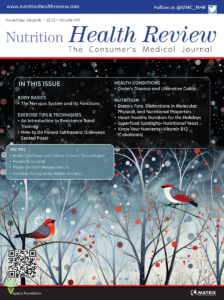 Over the years, research has shown that consuming spicy foods has a myriad of beneficial effects on health. Many of these health effects are attributed to capsaicin, which is the compound responsible for making peppers spicy. One study from 2015 found that eating spicy food everyday reduced the risk of death by 14 percent; the authors noted an inverse association between spicy food consumption and deaths due to cancer, ischemic heart diseases, and respiratory diseases.1 In this article, we provide a brief overview of some of the health benefits of spicy foods.
Over the years, research has shown that consuming spicy foods has a myriad of beneficial effects on health. Many of these health effects are attributed to capsaicin, which is the compound responsible for making peppers spicy. One study from 2015 found that eating spicy food everyday reduced the risk of death by 14 percent; the authors noted an inverse association between spicy food consumption and deaths due to cancer, ischemic heart diseases, and respiratory diseases.1 In this article, we provide a brief overview of some of the health benefits of spicy foods.
Gastrointestinal Health
It is a common misconception that spicy foods can cause stomach ulcers; however, the real culprit is more commonly nonsteroidal anti-inflammatory drug (NSAID) use or the bacteria Helciobacter pylori (H. pylori).2,3 In fact, capsaicin can protect against stomach ulcers by inhibiting H. pylori growth.2 Furthermore, capsaicin aids in inhibiting acid production in the stomach,3,4 which promotes the healing of ulcers.
In addition to helping with ulcers, eating spicy foods has a positive effect on the gut microbiome. Research has shown that capsaicin can increase the growth healthy gut flora while decreasing the presence of bad bacteria.5,6
Cardiovascular Health
In one review, researchers observed that individuals who ate chili pepper had a 26-percent relative reduction in cardiovascular mortality, compared to those who rarely or never ate chili peppers;7 however, only four studies were included in the review, which limits the generalizability of their findings.
Consuming spicy foods has been associated with lower levels of low-density lipoprotein (LDL, or “bad”) cholesterol and higher levels of high-density lipoprotein (HDL, or “good”) cholesterol.5,8
Capsaicin is known to release calcitonin gene-related peptide (CGRP), which plays a role in decreasing blood pressure.2,9 In animal models, spicy foods have been found to reduce the risk of high blood pressure,2,6 though more research must be done to confirm this effect in humans.
Diabetes
Many studies have described the role of capsaicin in diabetes. Research has shown that regularly eating chili peppers can ameliorate hyperglycemia and hyperinsulinemia following meals.2,4 Additionally, capsaicin can increase glucose absorption, thus playing an important role in lowering blood glucose levels.2,4,10
Capsaicin has the potential to improve glucose homeostasis, though evidence for this largely comes from animal models.2,4,9,10 As such, more research needs to be done on capsaicin role in glucose homeostasis and its potential to decrease the risk of Type 2 diabetes in humans.
Cancer
Researchers have uncovered an association between spicy food and reduced risk of certain types of cancer. One study involving Chinese adults found that spicy food consumption was significantly associated with reduced risk of esophageal cancer, as well as reduced mortality from esophageal cancer. There was also a weaker correlation between spicy food intake and reduced risk of stomach and colorectal cancers.11
Capsaicin has been observed to regulate the cell cycle, including apoptosis and autophagy (normal processes of cell death), which can prevent the proliferation of various types of cancers.2,12 However, some animal studies have observed a co-carcinogenic effect in capsaicin,2 so further research is needed to fully understand its role in cancer development and treatment.
Pain
The benefits of spice aren’t just limited to food! Topical formulations of capsaicin can be used to treat a variety of painful conditions.
In one study among individuals with diabetic peripheral neuropathy, the use of topical capsaicin resulted in significant pain relief.10 Another study showed that an 8% capsaicin patch significantly reduced localized neuropathic pain, and of the study participants who experienced a 30-percent or greater reduction in pain intensity, 26 percent reached almost complete pain relief.13
Topical capsaicin can also improve itch, although it may cause side effects, such as a slight burning sensation.2,14 Topical capsaicin can also be used to relieve pain from osteoarthritis, muscle sprains or strains, and post-herpetic neuralgia.6,15
Bottom Line
If you can tolerate a little heat, spicy foods can be a great addition to your diet.
Editor’s note: Please consult with a qualified healthcare professional to determine if you should add spicy foods to your diet.
Sources
- Lv J, Qi L, Yu C, et al. Consumption of spicy foods and total and cause-specific mortality: population based cohort study. BMJ. 2015;351:h3942.
- Fattori V, Hohmann MS, Rossaneis AC, et al. Capsaicin: current understanding of its mechanisms and therapy of pain and other pre-clinical and clinical uses. Molecules. 2016;21(7):844.
- McDonald E. A hot topic: are spicy foods healthy or dangerous? UChicago Medicine. 23 Sep 2018. https://www.uchicagomedicine.org/forefront/health-and-wellness-articles/spicy-foods-healthy-or-dangerous. Accessed 28 Sep 2022.
- Xiang Y, Xu X, Zhang T, et al. Beneficial effects of dietary capsaicin in gastrointestinal health and disease. Exp Cell Res. 2022;417(2):113227.
- Cleveland Clinic. Is spicy food good for you? 2 Aug 2021. https://health.clevelandclinic.org/is-spicy-food-good-for-you/. Accessed 28 Sep 2022.
- Armstrong L. Is spicy food good for your health? GoodRx. 19 Jan 2022. https://www.goodrx.com/well-being/diet-nutrition/is-eating-spicy-food-good-for-you. Accessed 28 Sep 2022.
- American Heart Association. People who eat chili pepper may live longer? ScienceDaily. 9 Nov 2020. https://www.sciencedaily.com/releases/2020/11/201109074114.htm.Accessed 28 Sep 2022.
- Xue Y, He T, Yu K, et al. Association between spicy food consumption and lipid profiles in adults: a nationwide population-based study. Br J Nutr. 2017;118(2): 144–153.
- Sun F, Xiong S, Zhu Z. Dietary capsaicin protects cardiometabolic organs from dysfunction. Nutrients. 2016;8(5):174.
- Wang P, Yan Z, Zhong J, et al. Transient receptor potential vanilloid 1 activation enhances gut glucagon-like peptide-1 secretion and improves glucose homeostasis. Diabetes. 2012;61(8):2155–2165.
- Chan WC, Millwood IY, Kartsonaki C, et al. Spicy food consumption and risk of gastrointestinal-tract cancers: findings from the China Kadoorie Biobank. Int J Epidemiol. 2021;50(1):199–211.
- Adetunji TL, Olawale F, Olisah C, et al. Capsaicin: a two-decade systematic review of global research output and recent advances against human cancer. Front Oncol. 2022;12:908487.
- Vieira IF, de Castro AM, Loureiro MDC, et al. Capsaicin 8% for peripheral neuropathic pain treatment: a retrospective cohort study. Pain Physician. 2022;25(4):E641–E647.
- Malewicz NM, Rattray Z, Oeck S, et al. Topical capsaicin in poly(lactic-co-glycolic)acid (PLGA) nanoparticles decreases acute itch and heat pain. Int J Mol Sci. 2022;23(9):5275.
- Mayo Clinic. Capsaicin (topical route). https://www.mayoclinic.org/drugs-supplements/capsaicin-topical-route/description/drg-20062561. Accessed 28 Sep 2022.





